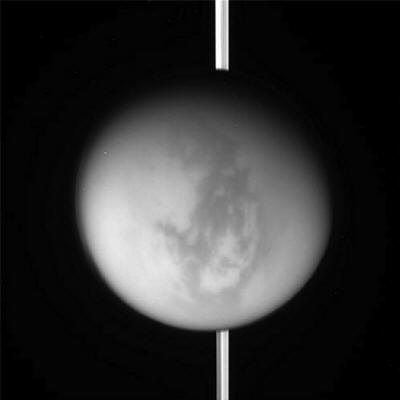|

by Stephen Smith
September 27, 2011
from
Thunderbolts Website

Titan bisected by
Saturn's rings.
Credit:
NASA/JPL/Space Science Institute
A recent close encounter with Titan
uncovered more surface anomalies on the haze-shrouded moon.
On October 15, 1997 NASA launched the
Cassini-Huygens spacecraft
atop a Titan IV-Centaur rocket. The six ton payload was the largest
deep space mission ever deployed, requiring a seven year journey to
Saturn. Gravitational assists from Venus, Earth, and Jupiter were
needed because Cassini could not carry enough fuel for a straight
route to Saturn.
Cassini-Huygens entered orbit around Saturn on June 30, 2004. Its
name has been changed twice since then.
The Cassini Equinox Mission
was a two-year extension which began on July 1, 2008, following the
completion of its Prime Mission that lasted from July 1, 2004 to
June 30, 2008.
Subsequently, its name was changed to the
Cassini-Solstice Mission, named for the summer solstice on Saturn
that will take place in May 2017.
On September 12, 2011 Cassini completed close flyby number 78 of
Titan, coming within 5800 kilometers of the giant moon’s cloud tops.
Titan has long been a mystery to planetary scientists. Perhaps the
most perplexing find is that methane gas continuously escapes from
Titan’s low-gravity environment. Sunlight is also dissociating
methane molecules in its upper atmosphere, changing them back into
their carbon and hydrogen constituents.
Since consensus theories
propose Titan’s age to be in the billions of years, how has its
dense atmosphere survived for those countless eons?
NASA insists that Titan’s atmosphere is somehow constantly
replenished, because so much of it is destroyed by sunlight and
leaks away to space. Current 'theories' about the formation of the
Solar System imply that Titan is old, billions of years old. With so
much loss at such a rapid rate, Titan’s atmosphere should have
evaporated a long time ago.
Astrophysicists can only imagine oceans
of liquid methane beneath the cloud cover as a source of
replenishment.
When the Huygens lander touched down
(above video) on a flat, rocky plain (below video), the
idea that Titan is “wet” with hydrocarbons suffered a serious blow.
No methane was falling from the sky and no methane puddles were
visible.
Rather, in keeping with images sent from orbit, a vast dry
area covered with “sand dunes” was seen.
Based on years of analysis, Electric Universe advocates think that
the Solar System was once the scene of devastating encounters
between charged bodies in the recent past. Giant clouds of plasma
rife with electric arc discharges disrupted the orbital arrangement
of planets and moons, as well as adding new objects.
Large bodies
like Titan all the way down to the small particles that make up
Saturn’s rings might have recently come into existence.
If Titan is a new addition to Saturn’s family of 60 moons and
counting, then its dense atmosphere does not presuppose
replenishment, but juvenescence. Titan is not losing an ancient
atmosphere, its atmosphere is new.
The
Electric Universe hypothesis paints a more complete picture when
data from space probes and telescopes are inserted.
It is not
considered a viable model to mainstream researchers because of the
time element involved. Its opponents presume that the Solar System
is the same as it was since its formation billions of years ago. A
10,000 year time span for planets and moons to be altered or
begotten is blasphemous to the consensus opinion.
However, when the time for change in a paradigm arrives, change is
inevitable.
The growing interest and adherence to the Electric
Universe paradigm means that changes to human thought are coming
soon.
|


